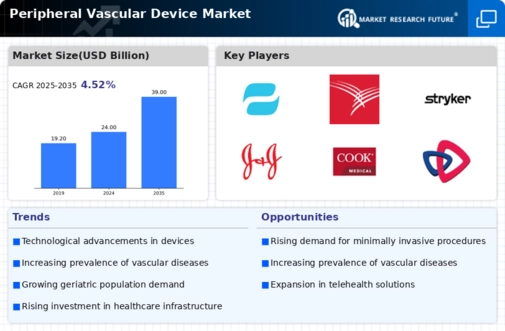Aging Population and Lifestyle Changes
The demographic shift towards an aging population, coupled with lifestyle changes, is a significant driver for the Peripheral Vascular Device Market. As individuals age, the risk of developing vascular diseases increases, leading to a higher demand for effective treatment options. Additionally, lifestyle factors such as obesity, sedentary behavior, and smoking contribute to the rising incidence of peripheral vascular conditions. Data indicates that the number of individuals aged 65 and older is expected to double by 2050, further amplifying the need for peripheral vascular devices. This demographic trend presents a substantial opportunity for manufacturers to innovate and expand their product offerings to cater to this growing patient population.
Technological Innovations in Device Design
Technological advancements play a crucial role in shaping the Peripheral Vascular Device Market. Innovations such as drug-eluting stents, bioresorbable scaffolds, and advanced imaging techniques are enhancing the efficacy and safety of vascular interventions. The introduction of these cutting-edge technologies is expected to improve patient outcomes and reduce complications associated with traditional devices. Market data indicates that the segment of drug-eluting devices is anticipated to witness substantial growth, driven by their ability to minimize restenosis rates. As manufacturers continue to invest in research and development, the market is likely to see a surge in novel devices that cater to the evolving needs of healthcare professionals and patients alike.
Regulatory Support and Reimbursement Policies
Regulatory support and favorable reimbursement policies are pivotal in shaping the Peripheral Vascular Device Market. Governments and regulatory bodies are increasingly recognizing the importance of peripheral vascular devices in improving patient outcomes. As a result, there is a trend towards streamlined approval processes for innovative devices, which can facilitate quicker market entry. Furthermore, reimbursement policies that cover these devices are essential for encouraging their adoption among healthcare providers. Market data suggests that regions with supportive reimbursement frameworks are likely to experience higher growth rates in device utilization. This regulatory environment not only fosters innovation but also enhances accessibility for patients, thereby driving overall market expansion.
Rising Incidence of Peripheral Vascular Diseases
The increasing prevalence of peripheral vascular diseases (PVD) is a primary driver for the Peripheral Vascular Device Market. Conditions such as atherosclerosis and peripheral artery disease are becoming more common, particularly among aging populations. According to recent data, the incidence of PVD is projected to rise significantly, with estimates suggesting that by 2025, nearly 20% of individuals over the age of 65 may be affected. This growing patient population necessitates the development and adoption of advanced peripheral vascular devices, as healthcare providers seek effective solutions to manage these conditions. Consequently, the demand for innovative devices, including stents and balloons, is likely to escalate, thereby propelling market growth.
Increasing Demand for Minimally Invasive Procedures
The shift towards minimally invasive procedures is significantly influencing the Peripheral Vascular Device Market. Patients and healthcare providers alike are increasingly favoring these techniques due to their associated benefits, such as reduced recovery times and lower complication rates. As a result, there is a growing demand for devices that facilitate these procedures, including catheter-based interventions and endovascular stents. Market analysis suggests that the minimally invasive segment is expected to expand rapidly, with a projected compound annual growth rate (CAGR) of over 8% in the coming years. This trend is likely to drive innovation and competition among manufacturers, as they strive to develop devices that meet the specific requirements of minimally invasive techniques.


















Leave a Comment